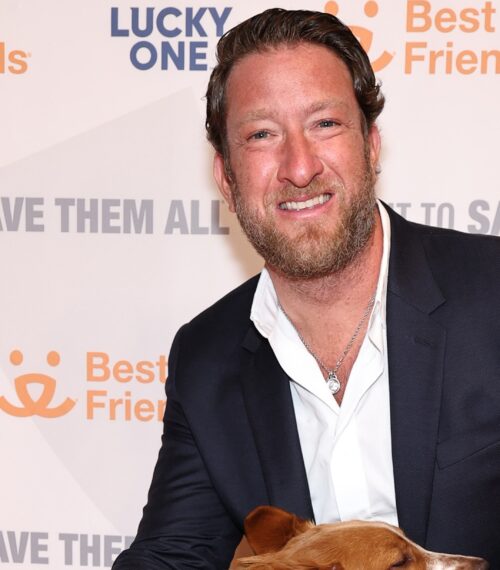Longtime Dancing With the Stars personality Maksim Chmerkovskiy is calling out the show’s latest casting move, taking issue with season 34 newcomer Jan Ravnik stepping into a professional partner role despite not having a ballroom background.
On the October 24 episode of The Penthouse With Peta, the podcast he co-hosts with wife and fellow DWTS pro Peta Murgatroyd, Chmerkovskiy voiced strong objections to Ravnik’s credentials — or lack thereof — for the job. Ravnik, known for dancing on Taylor Swift’s The Eras Tour, joined the current season as a pro paired with reality star Jen Affleck.
“I’m sorry, Jan has absolutely no business being a pro on Dancing with the Stars,” Chmerkovskiy said. “There’s zero foundation technique, quality, understanding of the partnership. Bro, I’m getting emotional. It is absurd, and this is unreal how blind we have to be and God forbid say what’s obviously there.”
Chmerkovskiy emphasized his critique was about the integrity of the competition and the responsibility that comes with coaching a celebrity through classic ballroom styles each week. “Jan, whoever he is, I have zero against him whatsoever,” he added. “No way, this was a missed opportunity.”
The Performance That Sparked The Debate
Chmerkovskiy pointed specifically to Ravnik and Affleck’s October 21 routine during Wicked Night as his prime example. The couple took on the foxtrot, a ballroom staple that prioritizes frame, rise and fall, and a clear lead-and-follow dynamic — areas Chmerkovskiy feels Ravnik hasn’t yet mastered.
“He had no idea what foxtrot is supposed to look like,” Chmerkovskiy said. “How are you going to expect him to teach it and deliver that message in a format that is completely different from even ballroom dancing? We had this criticism weeks ago, and I’m like, ‘Bro is anybody going to explain it to him?’”
While he acknowledged Ravnik showed flashes of promise early on — noting there was “some sort of direction” in one dance — Chmerkovskiy argued the improvement didn’t stick. According to the former DWTS pro, that progress “went off the cliff” in subsequent rehearsals with Affleck, who appears on Secret Lives of Mormon Wives.
For Chmerkovskiy, the issue isn’t about artistry or stage presence — areas where a high-profile tour dancer like Ravnik excels — but about the technical clarity a DWTS pro is expected to impart quickly under the show’s intense weekly turnaround.
Peta Murgatroyd Backs The Concern
Murgatroyd agreed with her husband’s assessment, sharing sympathy for Affleck’s position in the pairing and stressing that the “basics” are the building blocks contestants rely on to survive the show’s escalating difficulty.
“I feel bad because she’s not getting taught the basics that she needs,” Murgatroyd said. “She’s not getting taught the base of the dance.”
Murgatroyd also referenced Ravnik’s pop-world pedigree as a likely factor in his selection for the show, while underscoring that those credentials don’t automatically translate to teaching ballroom. “They hired him. He’s a Taylor Swift dancer. It’s the obvious reason why he is hired,” she said. “Apart from that, he’s a lovely guy. He looks great, he obviously is a great dancer. Hiring a non-ballroom dancer to teach ballroom dancing to a celebrity as a job is outrageous.”
Both Murgatroyd and Chmerkovskiy were careful to keep their criticism focused on casting rather than Ravnik personally. The pair praised his talent and professionalism in general, while arguing that the production’s decision ultimately puts the celebrity at a competitive disadvantage.
The Bigger Question About What Makes A DWTS Pro
DWTS pros are traditionally ballroom specialists who can choreograph, coach, and perform with celebrities of varying skill levels across Latin and Standard styles — all on a punishing weekly schedule. Casting a commercial or tour dancer as a pro brings a different skill set to the ballroom, one that emphasizes musicality, precision staging, and showmanship over the codified technique and partnering mechanics of dances like the foxtrot, quickstep, or waltz.
That distinction is at the core of Chmerkovskiy and Murgatroyd’s critique. Ballroom requires a specific foundation — frame control, weight transfer, lead and follow, heel and toe actions — that not only needs to look correct on the floor, but also has to be taught effectively to a non-dancer in a matter of days. Without that base, they argue, even a gifted performer can struggle to deliver the genre’s essentials, and a celebrity can miss out on the instruction that helps them grow week to week.
Ravnik’s résumé speaks for itself in the commercial dance world. But Chmerkovskiy’s comments highlight a longtime DWTS tension between star power and ballroom purity: Is the pro bench best served by revered technicians or by crossover performers who bring fresh energy? For the show’s veterans, technique is non-negotiable — and the mentor’s expertise is as crucial as the choreography itself.
Chmerkovskiy’s remarks also speak to the stakes for the celebrity partner. Affleck, like many contestants, depends on a pro to translate judges’ notes into actionable technique, scaffold choreography to match her ability, and build confidence across styles. In their view, putting a non-ballroom pro in that seat increases the degree of difficulty for the celebrity in a competition that already moves at breakneck speed.
As season 34 continues with themed installments like Wicked Night, the conversation around Ravnik’s hiring has doubled as a broader discussion of what DWTS expects from its pros and how those expectations shape the season’s outcomes. For Chmerkovskiy and Murgatroyd, the critique is simple: celebrate great dancers, but keep the pro roles reserved for ballroom specialists who can teach the craft under live-TV pressure.
Whether audiences agree with that standard or simply enjoy seeing new faces from across the dance world, the duo’s comments underline a familiar truth about DWTS: casting isn’t just about who can dance; it’s about who can coach.















































































































